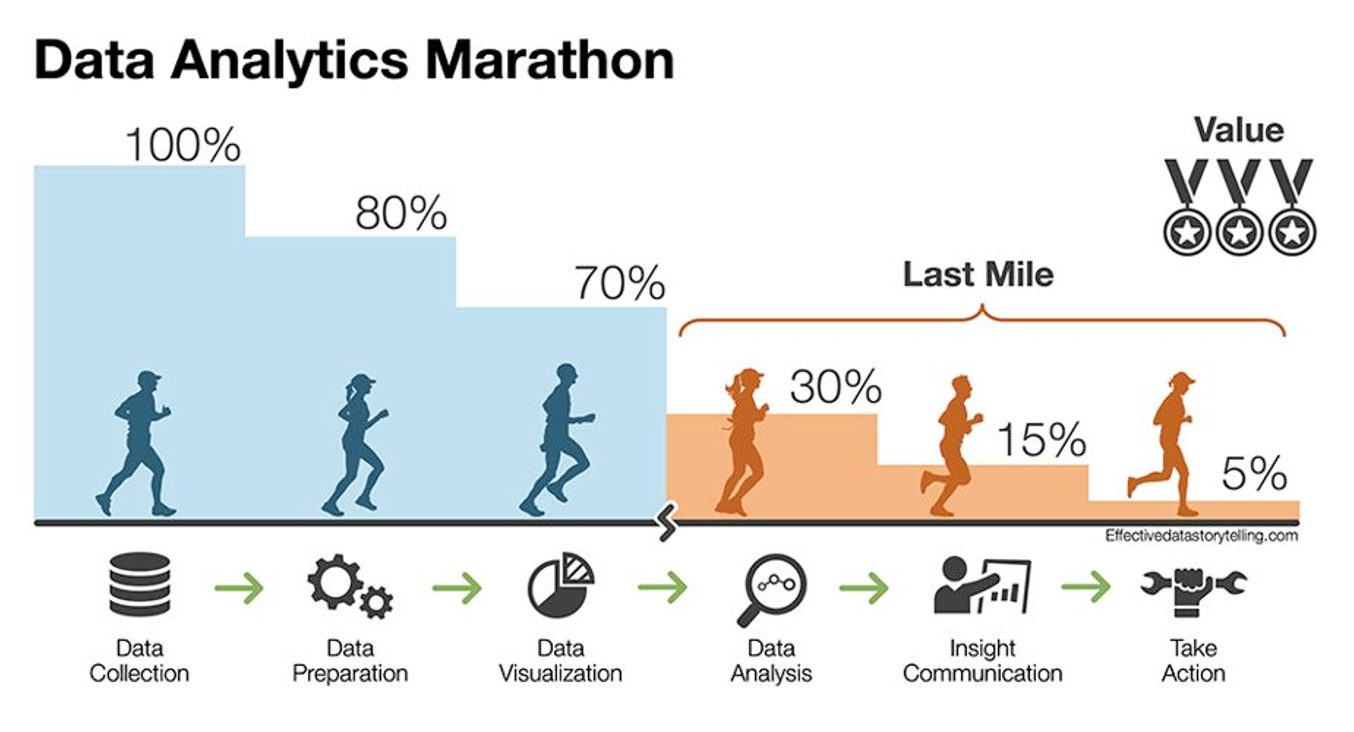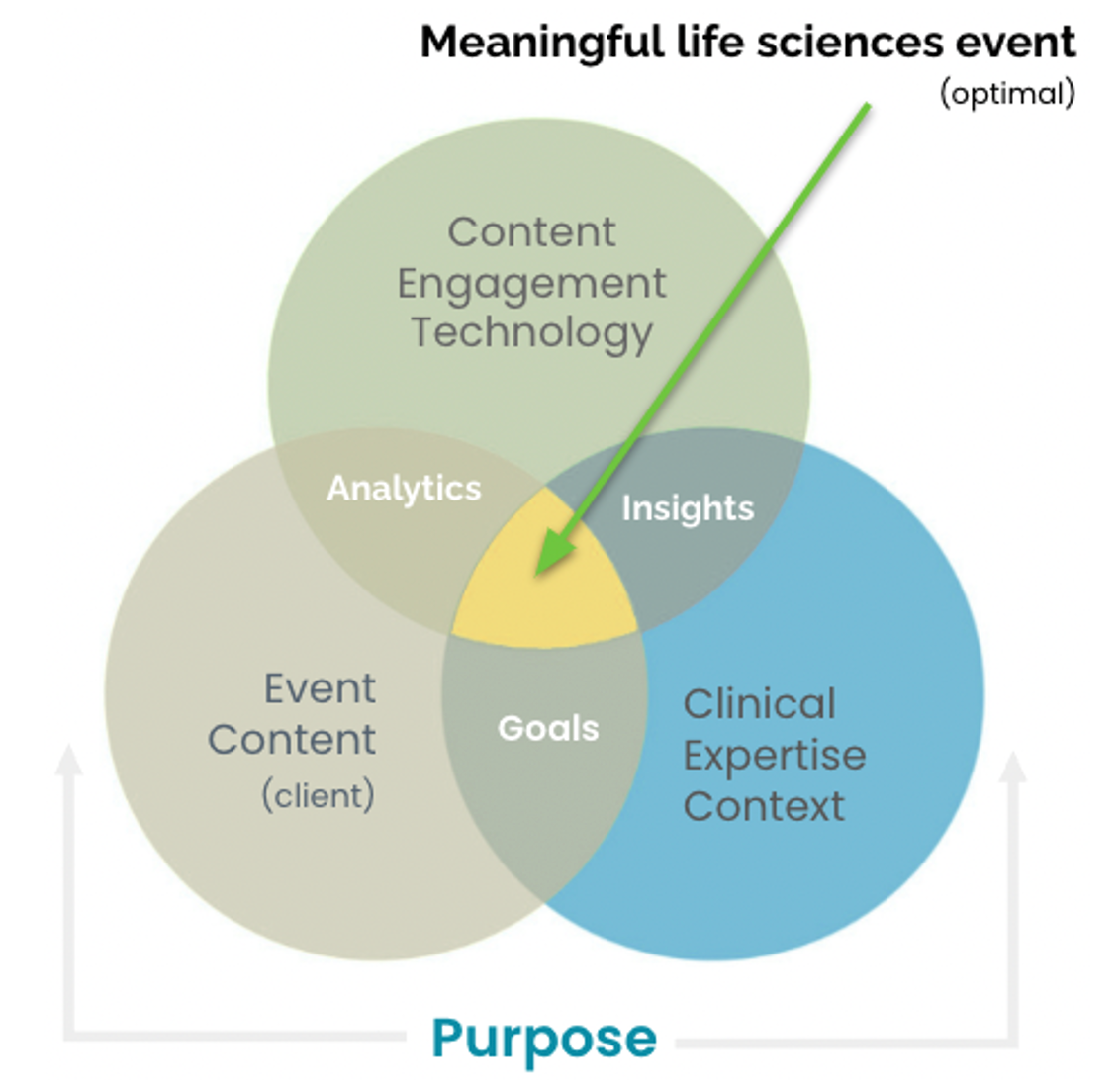If Content Is King, Context Is the Power Behind the Throne
New mediums of technology must be utilized correctly to reap full benefits.

Insights are the currency Medical Affairs trades in, so unlocking the potential to generate that currency should be a strategic priority before every meeting.
Event organizers regularly collect metrics from their participants, but what happens to all these data points when the event is over? Are the metrics collected even useful? Even the best information is worthless if it just sits in a spreadsheet and nobody looks at it.
In a recent survey, 75% of event organizers who responded said they needed help understanding the event data they collect. Many admit to being overwhelmed with the day-to-day management of events. It is important to point out that these challenges span across the various types of events within both R&D and Commercial.
According to Brent Dykes’ book on effective data storytelling, only 5% of companies collecting data are using it to take action. This is a huge, missed opportunity.

Plan for metrics needed to create meaningful events
It’s important for organizers to create a metrics capture plan prior to events that aligns with their strategic business goals. Starting with the end in mind and planning for success through that lens is the only way to ensure goals and return on investment (ROI) objectives are met. More importantly, it provides opportunities for those analyzing metrics to suggest recommendations to refine activity design and reassure invested stakeholders that those goals, and the unique problems they’re trying to solve, were addressed.
Achieving this moves these activities from isolated one-offs to integrated key tactical assets in an overarching strategic plan. Furthermore, it's only when the layering of expertise, engagement technology, and metrics analysis happens that those insights, combined with context of the activity’s goals, become truly actionable.
Best practice in planning for success includes strategic business goals alignment sessions with content developers and content technology providers. Those calls should not only cover the objectives but drill down into the potential demographics of those attending the meetings to ensure a granular, meaningful view of the metrics later. For example, planning to capture and then analyze data by specialty, location, seniority, or even pre-determined opinions vastly improves the levers teams can pull when trying to unpick the insights lock.
Critical to data capture is involving content and technology teams earlier in planning, particularly in detailed slide reviews that reveal where engagement might be needed most based on what key messages you want the audience to retain. Presenters, who despite the best intentions may not have fully bought into the value that the metrics from their sessions provide, also need coaching to ensure the questions being asked of the audience land well.
Engineer content engagement
Professional support during any event improves content engagement adoption and increases the metrics capture yield required for actionable insights to be generated. There is a wealth of content engagement platforms available now, but only some come with the talent needed to weave a metrics plan into the running order and look for last-minute engagement opportunities.
Add the variables of in-person, virtual, and hybrid audiences we now cater for, and that same team will need to understand the learning challenges each audience faces in its respective location and adjust accordingly. Active session monitoring helps with this, especially when many of the insights come from verbal conversations, particularly prevalent in advisory board settings.
With virtual and hybrid formats still relatively new (and necessary), stakeholders are looking for solutions that create an equally meaningful experience for onsite and offsite audiences, yet yield a consolidated and truly representative capture of engagement metrics to interpret into insights.
Beware of vanity metrics
The Content Marketing Institute describes vanity metrics as “…easy to obtain in large numbers—all platforms supply them; it’s difficult because they are often ambiguous when it comes to reporting a return on investment or value to a business.”
In the case of meetings and events, vanity metrics reported are often how many people logged on or how many times a speaker biography was viewed. While these types of bland metrics have a place—and certainly for meetings, where there is regulatory compliance to report attendance—they only tell a fraction of the story and, critically, aren’t typically actionable.
The real value of engaging audiences with content, and measuring it, comes when the specific goals for that meeting type have been used as the lens through which actions are taken. Here is a sample of that value:
Investigator meetings
- A typical goal: Ensure site teams can identify appropriate patients for screening and enrollment
- Recommended content engagement: Insertion of case studies into presentations with supporting polling opportunities to simulate patient screening scenarios and the like
- Planned metrics to capture: Polling data and ensuing discussion of results around inclusion/exclusion criteria
- Example of actionable insight: A review of the metrics could uncover problems with recruitment strategies that may be addressed at site initiation visits, monitoring visits, or via other clinical trial communications. Follow-on discussion can also open up to efficient recruitment strategies and invite meeting participants to share ideas or success stories.
- Why this is important: Patient recruitment is a key driver for clinical trial efficiency. This insight demonstrates how the investigator meeting may be a tactical asset integral to the success of the trial, rather than an isolated event.
Advisory boards
- A typical goal: Gain insights on the current clinical landscape
- Recommended content engagement: Use of cases or scenarios to obtain advice on decision making in practice; polling questions to assess opinion on appropriate patient selection or treatment selection
- Planned metrics to capture: Polling responses on case/scenario combined with key demographics
- Example of actionable insight: In a single event—clear, quick feedback from present advisors; in a series—regional differences may be observed by analysis of consistent question responses, broken down by location. Practice patterns may be identified by analysis broken down by specialty, years in practice, or practice setting.
- Why this is important:Organizers make focused recommendations for future strategic planning and may be able to address any regional/other variations.
Speaker training
- A typical goal: Educate speakers on compliance-related responsibilities as contracted by a sponsor (PhRMA code, etc.)
- Recommended content engagement: Insertion of “save slide” icons to denote key content; polling questions to assess knowledge transfer (correct/incorrect); pre-post assessment to measure impact; use of scenarios/cases to assess decision-making, predict speaker response
- Planned metrics to capture: Level of engagement with key content; polling (n% correct pre-post); polling responses to assess decisions made
- Example of actionable insight: That the impact of training content was measurable. Identify any potential compliance violations/risks in a safe training environment.
- Why this is important: Predictor of speaker performance.Documents efforts of sponsors to ensure fully trained speakers. Risk mitigation effort.
- Leveraging content engagement technology, clinical expertise-driven context, and curated content moves reporting past vanity metrics and into the realm of storytelling analytics powered by meaningful experiences.

Programmatic insights for the win
A single event only provides a snapshot in time of the art of the possible. Aggregating those snapshots can generate a unique source of reference to refine activity design, content effectiveness, attendee engagement or selection, and faculty performance, as well as arm stakeholders with evidence of continued activity outcomes success year-round.
Annual or quarterly reviews of the benchmarked insights from meetings and events is the key to unlocking a program's potential. This can be achieved either through API transfer of engagement-enriched data or structured insights workshops with key stakeholders and partners.
The next time you or someone in your organization is planning an important meeting, think about asking the following questions:
- What are your business goals?
- Are you collecting metrics, and if so, are they going to lead to reaching your goals?
- What content do you want to be most compelling?
- Are you leveraging the right technology for the content to land?
- Can we prove all the participants were trained effectively?
- Will the key messages hit their mark? How will we know?
In summary, medical affairs, R&D, and commercial groups collect data across all their initiatives, but without the context of their activity’s goals can struggle to transform it into tangible insights resulting in lost innovation opportunities, poor medical community engagement, limited market intelligence, and ultimately budget risk.
Going the extra mile and leveraging combinations of content engagement technology, meaningful metrics, and flawless service, alongside industry knowledge and expertise, develops actionable insights that are proven to improve business outcomes.
Chris Bryant, vice president of analytics and insights management, Array
References
- Dykes, B. Effective Data Storytelling: How to Drive Change With Data, Narrative and Visuals. Published by Wiley, 2019.
- Hochuli, D. The Right and Wrong Ways to Use Vanity Metrics. Content Marketing Institute. Published online, Feb. 10, 2020. Available at: https://contentmarketinginstitute.com/2020/02/vanity-metrics-marketing-goals/
Addressing Disparities in Psoriasis Trials: Takeda's Strategies for Inclusivity in Clinical Research
April 14th 2025LaShell Robinson, Head of Global Feasibility and Trial Equity at Takeda, speaks about the company's strategies to engage patients in underrepresented populations in its phase III psoriasis trials.
Amgen’s Imdelltra Demonstrates Significant Overall Survival Improvement in Small Cell Lung Cancer
April 16th 2025In the Phase III DeLLphi-304 trial, patients with small cell lung cancer administered Imdelltra achieved a statistically significant and clinically meaningful improvement in overall survival compared to standard-of-care chemotherapy.
The Misinformation Maze: Navigating Public Health in the Digital Age
March 11th 2025Jennifer Butler, chief commercial officer of Pleio, discusses misinformation's threat to public health, where patients are turning for trustworthy health information, the industry's pivot to peer-to-patient strategies to educate patients, and more.
Pfizer Discontinues Development of Danuglipron for Chronic Weight Management
April 15th 2025Despite meeting key pharmacokinetic goals, a potential case of drug-induced liver injury led Pfizer to conclude that danuglipron’s risk-benefit profile did not support further development for chronic weight management.